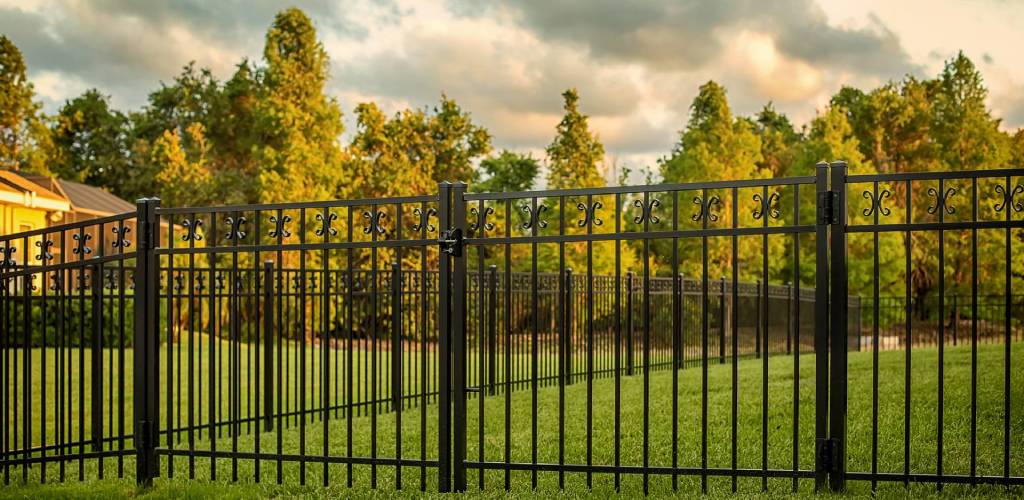All Categories
Featured

Amongst the most preferred options, timber, plastic, and light weight aluminum each offer special advantages and disadvantages. Below's a failure of the pros and disadvantages of these three usual fencing products.
Wood Fence. Wood fence has actually been a classic option for property owners due to its natural appeal and convenience.
Pros:. Aesthetic Allure: Timber uses a warm and traditional appearance that complements a selection of building designs. Customizable: It can be painted, stained, or cut right into unique designs to match individual choices. Affordable: Initially, timber fencing can be a budget friendly alternative compared to other products. Eco-Friendly: Wood is a renewable energy and can be sustainably sourced. Disadvantages:. High Upkeep: Wood needs routine securing, discoloration, or painting to stop rot, insect damage, and weathering. Longevity Problems: Without correct treatment, timber can warp, crack, or degeneration over time, particularly in locations with high moisture. Shorter Life-span: A wood fence normally lasts 10-20 years, depending upon the kind of timber and level of upkeep. Wood is perfect for those who value a typical look and agree to dedicate to its upkeep.
Plastic Secure Fencing. Vinyl is a modern, low-maintenance fence option that has grown in appeal over the last few years.

Pros:. Low Maintenance: Vinyl does not need painting, discoloration, or securing and can be conveniently cleaned with soap and water. Weather condition Resistant: It endures severe climate condition without rotting, rusting, or warping. Resilient: Plastic fencings can last 20-30 years with very little upkeep. Range of Styles: Available in many colors, layouts, and structures, some plastic choices resemble the appearance of timber. Disadvantages:. Greater Upfront Expense: Vinyl fencing can be extra expensive at first contrasted to wood. Brittleness in Winter: In extreme cool, plastic might crack or come to be brittle. Restricted Services: Specific panels can be difficult to change, calling for cautious matching to the existing fencing. Vinyl is best matched for homeowners looking for a resilient, low-maintenance option with contemporary looks.
Aluminum Fencing. Aluminum fence is a durable and light-weight option, commonly selected for its modern-day look and versatility.
Pros:. Rust-Resistant: Aluminum doesn't rust, making it an excellent choice for wet or damp climates. Reduced Maintenance: Needs marginal upkeep and is very easy to tidy. Resilient: While lightweight, light weight aluminum is solid sufficient to stand up to lots of ecological conditions. Long Lifespan: Can last numerous years without considerable wear or degeneration. Range of Styles: Supplies a streamlined and stylish look, frequently utilized for attractive or decorative functions. Cons:. Greater Expense: The preliminary investment for light weight aluminum fencing is greater than timber or vinyl. Less Privacy: Light weight aluminum fencings are commonly developed with open pickets, making them much less reliable for personal privacy. Prone to Damages: Although long lasting, light weight aluminum can be dented by strong influences. Light weight aluminum is perfect for those seeking a trendy, resilient choice that calls for marginal treatment.
Making the Right Selection. Each secure fencing material-- light weight aluminum, vinyl, and wood-- offers unique advantages and disadvantages. Your decision should rely on your certain priorities, such as budget, upkeep preferences, climate, and aesthetic objectives:
If you like a typical look and do not mind routine upkeep,Pick wood. Go with vinyl if you desire a low-maintenance, weather-resistant fence with contemporary appeal. Opt for light weight aluminum if you prioritize resilience, rust resistance, and a sleek design. By evaluating these disadvantages and pros, you can choose a fence product that boosts your residential or commercial property while fulfilling your useful requirements.
Latest Posts
Take Advantage of Special Auto Repair Offers in Chicago at Montclare Auto Repair
Published May 28, 25
1 min read
Explore the Greatest Auto Repair Discounts in Montclare, Chicago
Published May 26, 25
1 min read
Learn How to Save Big on Car Maintenance with Montclare Auto Repair’s Exclusive Deals
Published May 26, 25
1 min read
More
Latest Posts
Take Advantage of Special Auto Repair Offers in Chicago at Montclare Auto Repair
Published May 28, 25
1 min read
Explore the Greatest Auto Repair Discounts in Montclare, Chicago
Published May 26, 25
1 min read
Learn How to Save Big on Car Maintenance with Montclare Auto Repair’s Exclusive Deals
Published May 26, 25
1 min read